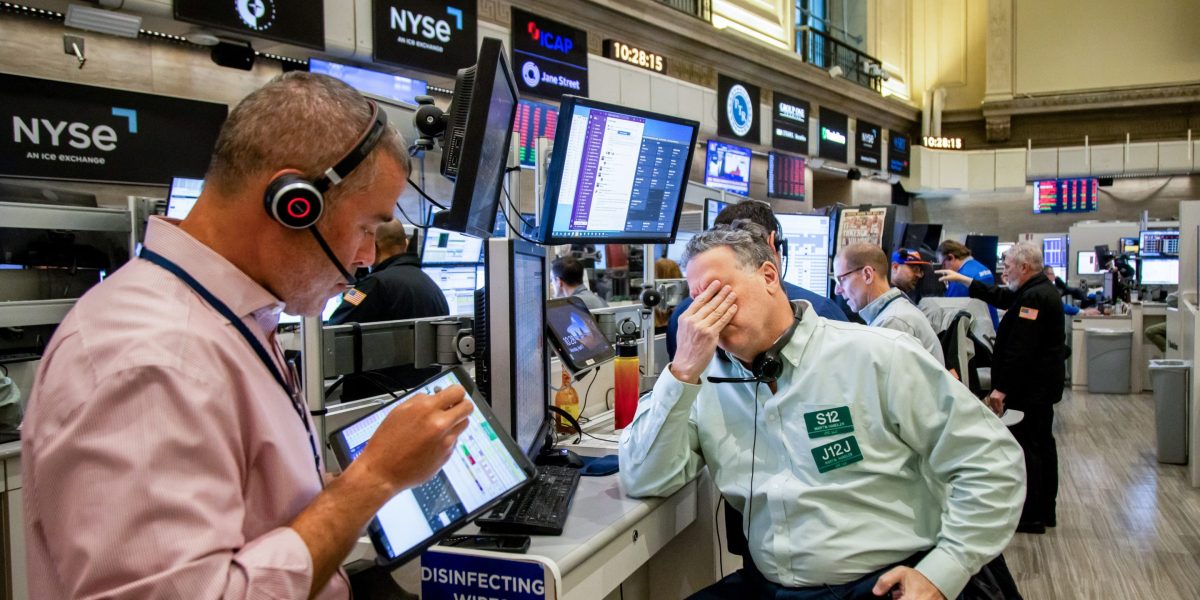- It’s been rough for most Americans’ 401(k)s since Trump unveiled his chart of reciprocal tariffs in the Rose Garden last week. The initial decline in the benchmark 10-year yield might have offered hope to homebuyers and sellers yearning for lower mortgage rates, but rates have remained elevated. The average fixed rate on a 30-year mortgage is still above 6.6%.
President Donald Trump’s sweeping reciprocal tariffs sparked chaos in the stock market, but bonds have also been on a wild ride. Amid one of Wall Street’s worst equity sell-offs in recent history, investors piled into safe-haven assets like Treasuries last week, but the apparent reversal of that trade means the ultimate impact on mortgages and other common borrowing costs for Americans remains unclear.
Early Monday, the yield on the benchmark 10-year Treasury note fell below 4% for the first time since October, down from about 4.8% in early January. That sharply reversed during a volatile trading session, however, as a rush out of bonds caused yields across all maturities to increase by at least 20 basis points, per Bloomberg. As of Tuesday afternoon, the 10-year yield approached the 4.30% mark as stocks pared back early gains to close in the red.
There’s been plenty of competing theories thrown out by market watchers for this dramatic retracement in yields as stocks and bonds curiously decline simultaneously.
“Everyone is trying to assign a narrative to why there was a big rise in Treasury yields yesterday,” Bill Merz, head of capital markets research at the U.S. Bank Asset Management Group, said Tuesday, “and the answer is people don’t know.”
There are a few straightforward explanations likely at play, though. Clearly, investors rushed to safety last week by selling stocks and buying Treasuries. It’s only natural, Merz said, for traders to partially unwind those positions.
“Thus, we’re seeing the bounce in Treasury yields,” he said.
Mortgage rates remain high as yields whipsaw
Yields, which represent an investor’s annual return, rise as bond prices fall—and vice versa. The former tends to happen if investors believe the Federal Reserve will be forced to hike rates, which makes the lower payments on existing bonds less attractive relative to new debt.
Therefore, it’s not surprising that yields have whipsawed as the market struggles to price what the Fed will do next. Through late February and early March, Merz noted, traders were expecting two-to-three quarter-point rate cuts. The turmoil after Wednesday’s tariff unveiling caused investors to suddenly price in four-to-five rate reductions, pushing yields downward, but some are less optimistic.
In a speech Friday, Fed Chair Jerome Powell indicated the central bank will continue its wait-and-see approach as widespread tariffs raise the prospect of dreaded stagflation, or rising inflation coupled with slowing growth. Investors had hoped for a sign the Fed stood ready to provide relief if the downturn persists, Merz said.
“The market didn’t get that,” he said.
It’s been rough for most Americans’ 401(k)s since Trump presented his reciprocal tariffs. The initial decline in yields could offer hope to homebuyers and sellers yearning for lower mortgage rates, which are based on the 10-year Treasury.
In fact, a video reposted by Trump on his social media platform, Truth Social, suggested the president wanted to push investors to buy Treasuries, pushing yields lower and pressuring the Fed to cut its policy rate, which banks use to borrow from each other overnight.
The White House did not immediately respond to Fortune’s request for comment about the bond market’s movement this week.
Even if the president were to deliberately tank the market to lower borrowing costs, the strategy could turn out to be ineffective. The average fixed rate on a 30-year mortgage still sits above 6.6% and has remained essentially flat in recent weeks, according to Freddie Mac.
The spread between that rate and the 10-year yield is currently quite wide, Merz said. It can increase during periods of market stress, he added, one reason being that investors might sour on mortgage bonds relative to safer treasuries.
“That’s not helpful for consumers and borrowers,” Merz said.
This story was originally featured on Fortune.com
Source link


 Entertainment8 years ago
Entertainment8 years ago
 Politics8 years ago
Politics8 years ago
 Entertainment8 years ago
Entertainment8 years ago
 Entertainment8 years ago
Entertainment8 years ago
 Tech8 years ago
Tech8 years ago
 Tech8 years ago
Tech8 years ago
 Tech8 years ago
Tech8 years ago
 Politics8 years ago
Politics8 years ago






